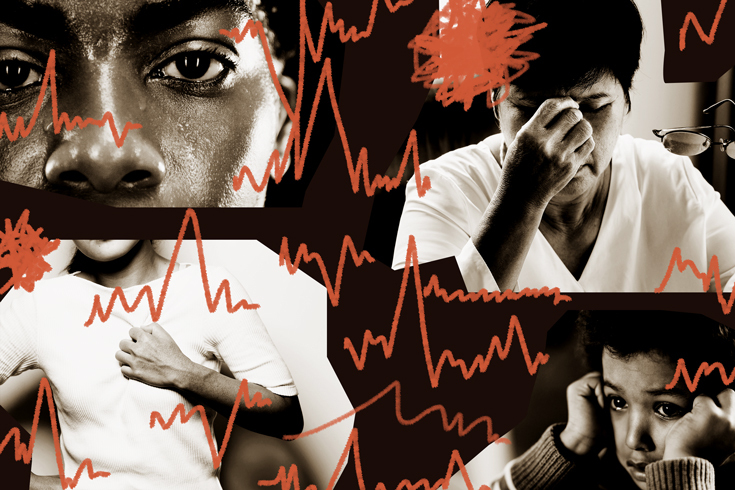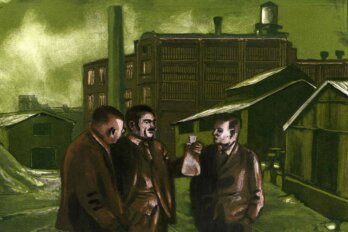When I was researching and writing my book, Nerve, COVID-19 did not yet exist. The SARS scare was a distant memory, and I had yet to learn the language of droplets and distancing, respirators and ventilators, isolation and quarantine. But, even as I have absorbed that new vocabulary in the last few weeks, I have also found myself thinking back to the terms and concepts that I explored while I was immersing myself in the science of fear.
We all know what it feels like to be afraid, but we don’t often stop and think about what that means physiologically. It has grounded me, a little, to understand so fully what is happening to me when I lie awake at night, sleepless with worry about my loved ones in cities far away, listening to my heart pound too loud and too fast in the dark. It’s my hope that this excerpt, exploring what fear is and how it works in our minds and our bodies, might offer some grounding to you too.
Fear, it seems at first, should be easy to identify and define. To borrow from that old judicial decision about the definition of obscenity: we know it when we feel it.
Putting that feeling into words can be harder. G. Stanley Hall, the nineteenth-century founder of the American Journal of Psychology and the first president of the American Psychological Association, described fear as “the anticipation of pain,” and that seems like a pretty good general definition to me. Fear of violence? Anticipatory pain. Fear of a breakup, the loss of someone you love? Anticipatory pain. Fear of sharks, of plane crashes, of falling off a cliff? Check, check, and check.
But what we need, really, isn’t just a solid catch-all definition. What we need, to understand the role of fear in our lives, is to examine the layers and varieties of fears that can afflict us.
There’s the sharp jab of alarm when you sense a clear, imminent threat: that car is going to hit me. There’s the duller, more dispersed foreboding, the feeling of malaise whose source you can’t quite pinpoint: something is wrong here; I don’t feel safe. There are spiralling, sprawling existential fears: I am going to flunk this exam, tank this interview, fail at life. And there are precise, even banal, ones: pulling this Band-Aid off is going to hurt. How do they all fit together? Or, put differently, to what extent does each stand apart?
According to Greek mythology, Ares, the god of war, had two sons who accompanied him into battle: Phobos, the god of fear, and Deimos, the god of dread. That seems like a useful distinction to start with—fear versus dread—and it’s one that’s echoed today by our distinction between fear and anxiety. Fear, generally speaking, is prompted by a clear and present threat: you sense danger and you feel afraid. Anxiety, on the other hand, is born from less tangible concerns: it can feel like fear but without a clear cause. Simple enough, at least in theory.
In Fear: A Cultural History, author Joanna Bourke gamely attempts to parse the distinctions between fear and anxiety. “In one case a frightening person or dangerous object can be identified: the flames searing patterns on the ceiling, the hydrogen bomb, the terrorist,” she writes. Whereas “more often, anxiety overwhelms us from some source ‘within’: there is an irrational panic about venturing outside, a dread of failure, a premonition of doom. . . . Anxiety is described as a more generalized state, while fear is more specific and immediate. The ‘danger object’ seems to be in front of us in fear states, while in anxiety states the individual is not consciously aware of what endangers him or her.”
But, as Bourke points out, that distinction has serious limitations. It’s entirely dependent on the ability of the fearful person to identify the threat. Is it legitimately, immediately dangerous? Or is the fear abstract, “irrational”? She offers the hydrogen bomb and the terrorist as examples of potentially clear and present threats, but both can also serve as anxiety-inducing spectres, ominous even when absent.
The distinction between fear and anxiety, then, can be murky, even as it can also be a useful and necessary line to draw. But setting the issue of a threat’s clear presence aside, there’s the matter of our fear response.
The scientists who study our emotional lives make distinctions between different categories of feelings. There are the primary emotions, our most basic and near-universal responses, found across cultures and even appearing, or at least seeming to us to appear, in other species: fear, anger, disgust, surprise, sadness, and happiness.
Think of them like primary colours, the foundational elements of a whole rainbow of emotion. Just as red and blue in combination can be used to create all the shades of purple, you can imagine some more precise feelings as being built by the primary emotions. Horror, for instance, is fear mixed with disgust—and, maybe, some shadings of anger and surprise. Delight could be happiness with a bit of surprise stirred in. And so on.
There are also the social emotions, the feelings that don’t stand alone like the primary emotions but are generated by our relationships to others: sympathy, embarrassment, shame, guilt, pride, jealousy, envy, gratitude, admiration, contempt, and more.
Of all these, fear is perhaps the most studied. But what does it really mean to study fear? What do we even mean, exactly, when we say “fear” in the context of scientific research? That’s a more complicated question than you might expect.
Traditionally, scientists have studied fear in animals by measuring their reactions to threatening or unpleasant stimuli—a rat’s freezing response when it is subjected to a small electric shock, for instance. In studying humans, scientists have more options and a broader array of tools. Most importantly, humans can self-report, verbally or in writing: yes, I felt afraid.
The complicating factor is that those two responses—the freezing and the feeling—are separate and distinct. As the neuroscientist Joseph LeDoux, an expert on the brain circuitry of fear, emphasizes in his book Anxious, we know that the physical fear response and the emotional feeling of fear are produced by two different mechanisms in the body.
For a long time, the working theory held that the feeling came first, in response to the fear stimulus, and then the physical response followed from the feeling. This is what’s known as the common sense, or Darwinian, school of thought. But it was more an assumption than a proven mechanism, and these days it has fallen out of favour.
Instead, as science has turned its attention to working out that elusive mechanism more concretely, neuroscientist Antonio Damasio has come up with an answer that, while provocative, ultimately feels right to me. The feeling, he argues in a pair of funny and wise books, Descartes’ Error and Looking for Spinoza, is actually derived from that same menu of physical reactions that we would typically view as accessories of, or adjacent to, our emotions.
For the purposes of his argument, Damasio makes an unusual distinction between “emotions”—by which, in this context, he specifically means the physical, measurable reactions of the body in response to an emotional stimulus, the physical fear response—and “feelings,” the intangible expressions of emotion in our minds. That may seem odd, or even nonsensical, but it’s a key to his case, so keep it in mind.
“We tend to believe that the hidden is the source of the expressed,” he writes in Looking for Spinoza. But he argues, instead, for a counterintuitive reversal of that order: “Emotions”—again, meaning physical reactions here—“and related phenomena are the foundation for feelings, the mental events that form the bedrock of our minds.”
All organisms have varying abilities to react to stimuli, from a simple startle reflex or withdrawal movement all the way up to more complex multipart responses, like the description of our physical fear processes above, which are Damasio’s “emotions.” Some of the more basic responses might look, to our eyes, like expressions of the feeling of fear, and in fact, the machinery that governs them is also implicated in the more complex processes. (My startle reflex, one of our oldest and simplest reactions, has certainly come into play at times when I’ve also felt afraid. Hello, raptors in the kitchen in Jurassic Park!) But the “emotions” are at the top of the heap in terms of complexity, and as such, not all organisms are capable of generating them.
Unlike some of the simpler fear reactions in simpler organisms (poke a “sensitive plant,” watch its leaves curl up), our emotions can be generated by stimuli both real—in the moment or remembered—and imagined. That’s the gift and the burden of the human mind.
But, for now, let’s stick with an in-the-moment example, like a strange noise heard in the night. The fact of the noise is captured by the sensory nerves in the ear and is relayed to the brain structures involved in triggering and then executing a response. Now your body is reacting in all the ways described above.
So far, so good? The next step, in Damasio’s formulation, is the creation of the feeling itself. We know that our bodies are laced with neurons and that they not only send out information from the brain but also receive it.
So, after the outgoing messages have gotten our hearts pumping, our sweat beading, and so on, a series of incoming messages returns to the brain, bearing all of that information about our physical state. Our brains, Damasio explains, maintain incredibly complex maps of the state of the body, from our guts to our fingertips, at all times.
And here’s the core of his argument: when the incoming messages bearing news of the body’s physical fear-state alter these maps, that’s when the feeling itself arises. Your brain learns from your body that your heart is pounding, your pupils are dilated, your goosebumps are standing at attention. Your brain does the math and says, Aha! I am afraid!
In his 1884 essay “What Is an Emotion?” philosopher and psychologist William James wrote,
If we fancy some strong emotion and then try to abstract from our consciousness of it all the feelings of its bodily symptoms, we find we have nothing left behind, no “mind-stuff” out of which the emotion can be constituted, and that a cold and neutral state of intellectual perception is all that remains. . . . What kind of an emotion of fear would be left if the feeling neither of quickened heart-beats nor of shallow breathing, neither of trembling lips nor of weakened limbs, neither of gooseflesh nor of visceral stirrings, were present, it is quite impossible for me to think.
Damasio picks up where James left off. But he doesn’t just draw on Victorian-era philosophizing to make his argument. He also works from case studies and his own research; for instance, the case of a Parkinson’s patient in Paris. The woman, who was sixty-five years old and had no history of depression or other mental illness, was undergoing an experimental treatment for her Parkinson’s symptoms. It involved the use of an electrical current to stimulate motor-control areas of her brain stem via tiny electrodes.
Nineteen other patients had undergone the treatment successfully. But, when the current entered the woman’s brain, she stopped chatting with the doctors, her eyes lowered, and her face slumped.
Seconds later, she began to cry, and then to sob. “I’m fed up with life,” she said through her tears. “I’ve had enough . . . I don’t want to live anymore . . . I feel worthless.” The team, alarmed, stopped the current, and within ninety seconds, the woman stopped crying. Her face perked up again, the sadness melting away. What had just happened? she asked.
It turned out, according to Damasio, that, instead of stimulating the nuclei that controlled her tremors, the electrode, infinitesimally misplaced, had activated the parts of the brain stem that control a suite of actions by the facial muscles, mouth, larynx, and diaphragm—the actions that allow us to frown, pout, and cry. Her body, stimulated not by a sad movie or bad news, had acted out the motions of sadness, and her mind, in turn, had gone to a dark, dark place. The feeling arose from the physical; her mind followed her body.
This whole thing seemed counterintuitive to me at first, reversing as it does the “common sense” view. But then I sat back and really thought about my experience of fear. How do I recall it in my memory? How do I try to explain it to other people? The fact is that I think of it mostly in physical terms: that sick feeling in my gut, the tightness in my chest, maybe some dizziness or shortness of breath.
Think about how you actually experience the feeling of happiness, of contentment, or of ease. For me, these manifest in the loosening of the typically tense muscles in my forehead and jaw, in my neck and shoulders. My eyes open wider, losing their worried squint. I breathe more deeply.
Or think about the sheer physicality of deep grief, how it wrecks your body as well as your mind. When I look back on the worst of my grief after my mom’s death, I remember it as headaches, exhaustion, a tight chest, a sense of heaviness, and lethargy. I felt sad, yes—sadder than I’ve ever been—and it was my body that told me how sad I was.
Excerpted from Nerve by Eva Holland. Copyright © 2020 by Eva Holland. Published by Allen Lane, an imprint of Penguin Canada, a division of Penguin Random House Canada Limited. Reproduced by arrangement with the Publisher. All rights reserved.






